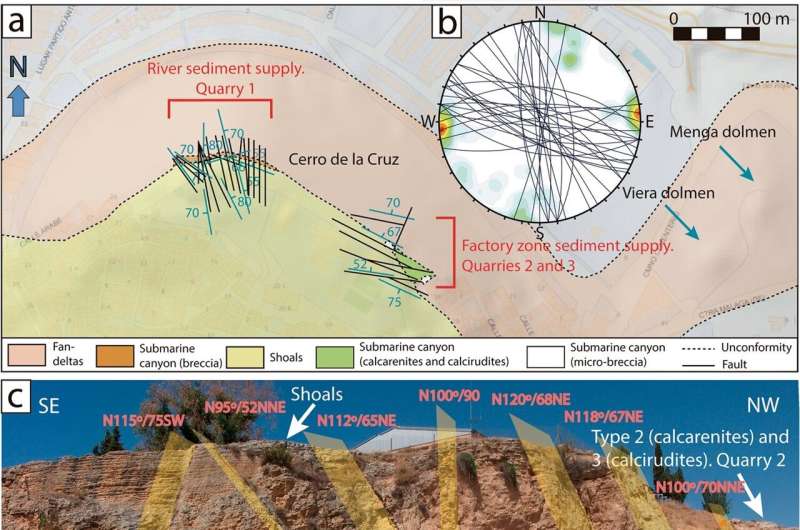(a) Artistic representation of mining activities for the extraction of foundation stone C-5 in Quarry No. 2 of Cerro de la Cruz. Drawing: Moisés Bellilty under the direction of José Antonio Lozano Rodríguez and Leonardo García Sanjuán. (b) Appearance of the thickness and shape of the C-5 foundation stone, the support on part of the O-10 orthostat and the mound structure. Excavations at the University of Malaga. Ferrer-Marqués, 1984. Conjunto Arqueológico Dólmenes de Antequera. (c) Convex morphology of the top of cornerstone C-5 and thickness of the tumular structure. Excavations at the University of Malaga. Ferrer-Marqués, 1984. Conjunto Arqueológico Dólmenes de Antequera. Credit: Scientific reports (2023). DOI: 10.1038/s41598-023-47423-y
A team of archaeologists, geologists and historians affiliated with several Spanish institutions discovered that the Menga dolmen represents one of the greatest technical feats of the Neolithic. In their study, published in Scientific reportsthe group used new technologies to learn more about the stone used to create the ancient burial site and to explore how wood and rope would have been used in its construction.
The Menga dolmen is an ancient burial mound located near Antequera, in the province of Malaga, Spain. It has been dated to around 5,700 years ago and is one of the largest known megalithic structures built in Europe. It was built on top of a hill using large stones, the largest of which weighed over 100 tonnes. In this new effort, the research team took a closer look at the composition of the stones used to build the mound, their origin and how they were transported.
To learn more about the composition of the stones, the research team used petrographic and stratigraphic analysis techniques, which showed that the stones were primarily calcarenites, a type of detrital sedimentary rock. In modern times, they are known as soft stones due to their fragility. According to the researchers, such a soft type of rock would have been difficult to transport without causing damage, a finding that suggests a certain level of technical sophistication.

(a) Geological map of tectonic joints on the DTM, showing the location of Menga and Viera and likely mining areas at Cerro de la Cruz. (b) Stereographic representation of joint groups. (c) Overview of tectonic fracturing present in quarry zones #2 and #3. (d) Groups of joints observed in quarry #1. (e) Example of a possible megalithic stone abandoned at quarry no. 1. Credit: Scientific reports (2023). DOI: 10.1038/s41598-023-47423-y
Moving and placing such large stones, they argue, would have required massive planning and engineering, particularly for the capstone which, as its name suggests, was laid atop the chamber to serve as a roof. Researchers say it weighs around 150 tonnes. They point out that placing such large rocks would have required the use of scaffolding and ropes, and that transporting them would have required level roads.
The research team also claims that the cemetery was built in a way to point in the desired direction. Its position aligns with the nearby mountains in a way that creates intricate light patterns inside the chamber. They also discovered that early engineers found a way to place stones on top of each other around the edges of the burial chamber to drain water seepage to prevent erosion.
More information:
José Antonio Lozano Rodríguez et al, The provenance of the stones of the Menga dolmen reveals one of the greatest technical feats of the Neolithic, Scientific reports (2023). DOI: 10.1038/s41598-023-47423-y
© 2023 Science X Network
Quote: A closer look at the Menga dolmen shows that it was one of the greatest technical feats of the Neolithic (2023, December 5) retrieved on December 6, 2023 from
This document is subject to copyright. Apart from fair use for private study or research purposes, no part may be reproduced without written permission. The content is provided for information only.



